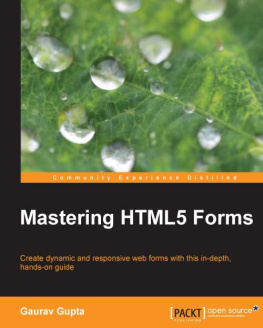Forms that Work
The Morgan Kaufmann Series in Interactive Technologies
Series Editors:
Stuart Card, PARC;
Jonathan Grudin, Microsoft;
Jakob Nielsen, Nielsen Norman Group
Measuring the User Experience: Collecting, Analyzing, and Presenting Usability Metrics
Tom Tullis and Bill Albert
Moderating Usability Tests: Principles and Practices for Interacting
Joseph Dumas and Beth Loring
Keeping Found Things Found: The Study and Practice of Personal Information Management
William Jones
GUI Bloopers 2.0: Common User Interface Design Donts and Dos
Jeff Johnson
Visual Thinking for Design
Colin Ware
User-Centered Design Stories: Real-World UCD Case Studies
Carol Righi and Janice James
Sketching User Experiences: Getting the Design Right and the Right Design
Bill Buxton
Text Entry Systems: Mobility, Accessibility, Universality
Scott MacKenzie and Kumiko Tanaka-ishi
Letting Go of the Words: Writing Web Content that Works
Janice (Ginny) Redish
Personas and User Archetypes: A Field Guide for Interaction Designers
Jonathan Pruitt and Tamara Adlin
Cost-Justifying Usability
Edited by Randolph Bias and Deborah Mayhew
User Interface Design and Evaluation
Debbie Stone, Caroline Jarrett, Mark Woodroffe, and Shailey Minocha
Rapid Contextual Design
Karen Holtzblatt, Jessamyn Burns Wendell, and Shelley Wood
Voice Interaction Design: Crafting the New Conversational Speech Systems
Randy Allen Harris
Understanding Users: A Practical Guide to User Requirements: Methods, Tools, and Techniques
Catherine Courage and Kathy Baxter
The Web Application Design Handbook: Best Practices for Web-Based Software
Susan Fowler and Victor Stanwick
The Mobile Connection: The Cell Phones Impact on Society
Richard Ling
Information Visualization: Perception for Design, 2nd Edition
Colin Ware
Interaction Design for Complex Problem Solving: Developing Useful and Usable Software
Barbara Mirel
The Craft of Information Visualization: Readings and Reflections
Written and edited by Ben Bederson and Ben Shneiderman
HCI Models, Theories, and Frameworks: Towards a Multidisciplinary Science
Edited by John M. Carroll
Web Bloopers: 60 Common Web Design Mistakes, and How to Avoid Them
Jeff Johnson
Observing the User Experience: A Practitioners Guide to User Research
Mike Kuniavsky
Paper Prototyping: The Fast and Easy Way to Design and Refine User Interfaces
Carolyn Snyder

Forms that Work

Designing Web Forms for Usability
Caroline Jarrett
Gerry Gaffney

Morgan Kaufmann Publishers is an imprint of Elsevier.
30 Corporate Drive, Suite 400, Burlington, MA 01803, USA
This book is printed on acid-free paper.
2009 by Elsevier Inc. All rights reserved.
Designations used by companies to distinguish their products are often claimed as trademarks or registered trademarks. In all instances in which Morgan Kaufmann Publishers is aware of a claim, the product names appear in initial capital or all capital letters. All trademarks that appear or are otherwise referred to in this work belong to their respective owners. Neither Morgan Kaufmann Publishers nor the authors and other contributors of this work have any relationship or affiliation with such trademark owners nor do such trademark owners confirm, endorse or approve the contents of this work. Readers, however, should contact the appropriate companies for more information regarding trademarks and any related registrations.
No part of this publication may be reproduced, stored in a retrieval system, or transmitted in any form or by any meanselectronic, mechanical, photocopying, scanning, or otherwisewithout prior written permission of the publisher.
Permissions may be sought directly from Elseviers Science & Technology Rights Department in Oxford, UK: phone: (+44) 1865 843830, fax: (+44) 1865 853333, E-mail: permissions@elsevier.com. You may also complete your request online via the Elsevier homepage ( http://elsevier.com ), by selecting Support & Contact then Copyright and Permission and then Obtaining Permissions.
Library of Congress Cataloging-in-Publication Data
Application Submitted
ISBN: 978-1-55860-710-1
Typeset by Charon Tec Ltd., A Macmillan Company.
( www.macmillansolutions.com )
For information on all Morgan Kaufmann publications, visit our Web site at www.mkp.com or www.elsevierdirect.com
Printed in China
09 10 11 12 13 14 15 16 5 4 3 2 1

Foreword
In the beginningdozens of years agoresearch papers crawled out of the primordial ooze somewhere in Switzerland to form the World Wide Web.
People in university basements posted the papers, and people in other university basements around the world could read them. Read-only.
Then one day someone in one of the basements thought, Wait. Why couldnt the people who read these things send us information, too? And thus < form > < /form > was born.
And although no one knew it at the time, e-commerce was born, too, because as Caroline and Gerry explain in the pages youre about to read, forms enable a conversation between Web publisher and Web user. It was such a powerful and useful idea that theres hardly a site today that doesnt have a formor dozens of forms.
And since weve all used forms all of our lives, we know just how unpleasant bad forms can be:
 Forms that ask questions you dont know how to answer
Forms that ask questions you dont know how to answer
 Forms with multiple-choice questions that dont have the choice you want
Forms with multiple-choice questions that dont have the choice you want
 Forms that ask for too much information, or information youd rather not give
Forms that ask for too much information, or information youd rather not give
 Forms with huge quantities of confusing instructions
Forms with huge quantities of confusing instructions
and on and on.
In an ordinary conversation, we work these things out by asking for and offering clarifications (Do you mean my average income lately, or for my whole life? How many children do I have, or how many are living at home?). But since a form can only ask the questions we tell it to ask, in exactly the way we tell it to ask them, a good form has to be completely clear and completely self-explanatory. Thats where this book comes in.
Its not just that I like her personally (although she is, as wed say over here, a really good egg); its that shes one of the handful of people whose opinions about usability I always want to hear.
And Ive always thought of her as
Next page










 Forms that ask questions you dont know how to answer
Forms that ask questions you dont know how to answer